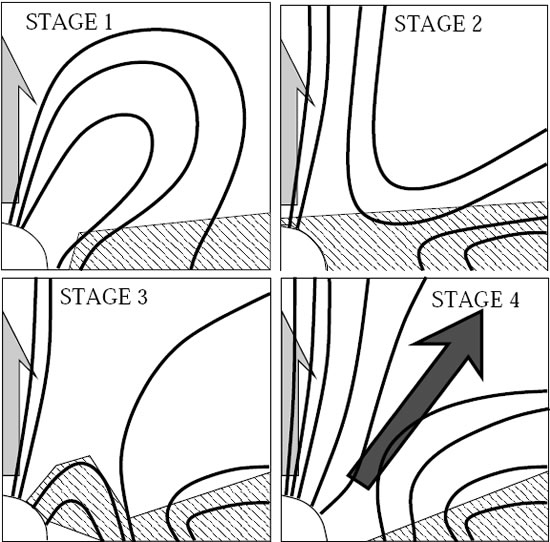研究成果藝廊 > 理論天文物理理論天文物理
(Theory)
研究成果藝廊
理論天文物理理論天文物理
(Theory)
| Magnetospheric Accretion and Ejection of Matter in Resistive Magnetohydrodynamic Simulations |
|
圖片來源: Čemeljić M, Shang H and Chiang T-Y

A schematic sketch of the evolution in star-disk interaction.
|
| By solving the resistive MHD equations with our version of the Zeus-3D code with implemented resistivity, we study the effect of magnetic diffusivity in the magnetospheric accretion-ejection mechanism. We show that quasi-stationary outflows consisting of axial and conical components can be launched from a purely resistive magnetosphere. We identify four stages of magnetospheric interaction with distinctly different geometries of the magnetic field, and describe the effect of magnetic reconnection in re-shaping the magnetic field. The stages are as shown in the schematic sketch:1) the initial stellar dipole gets pinched during the relaxation, when matter flushes in toward the central star; 2) the magnetic field lines are open after reconnection, and disk matter can reach the surface of the star; 3) the disk matter retracts and a funnel flow forms from the disk inner radius and accretes a matter onto the star; 4) the system reaches a quasi-steady state, settling into a configuration consisting of an open stellar field and field footed in the disk. The arrows indicate the directions of the matter outflow. The axial outflow can be on and off many times before entering into the quasi-stationary state. In the fourth stage, a conical outflow forms, which is reaching a quasi-stationary state (marked with black shadowed arrow). (Čemeljić M, Shang H and Chiang T-Y, 2013, ApJ, 768, 5) |
 asiaa.sinica.edu.tw 媒體連絡: epo
asiaa.sinica.edu.tw 媒體連絡: epo asiaa.sinica.edu.tw
asiaa.sinica.edu.tw